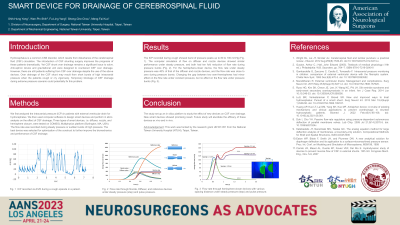Smart device for drainage of cerebrospinal fluid
Smart Device for Drainage of Cerebrospinal Fluid
Friday, April 21, 2023


Shih-Hung Yang, MD, PhD (he/him/his)
Staff Neurosurgeon
National Taiwan University Hospital
Taipei, Taiwan (Republic of China)
ePoster Presenter(s)
Introduction: Hydrocephalus is a common CNS disorder, which results from disturbance of the cerebrospinal fluid (CSF) circulation. The introduction of CSF shunting surgery improves the prognosis of these patients dramatically. Yet CSF shunt overdrainage remains a significant issue to solve. Anti-siphon device and gravitational unit were devised to counteract CSF overdrainage. However, there are still patients suffering from CSF overdrainage despite the use of the above devices. Overdrainage of the CSF shunt may result from short bursts of high intracranial pressure when the patients cough or cry vigorously. Temporary blockage of CSF drainage during extreme pressure scenario could potentially fix this problem.
Methods: We used computer software to design smart devices and perform in silico analysis on the effect of CSF drainage. Three types of smart devices, i.e. diffuser, nozzle, and hemisphere closure, were tested on COMSOL Multiphysics platform (Burlington, MA, USA). The flow rate was recorded during steady pressure or sudden bursts of high pressure. The best device was selected for optimization of the construct to further improve the biomechanics and performance of CSF drainage.
Results: The diffuser and nozzle devices showed similar performance under steady pressure, and both had ten fold reduction of flow rate during pressure bursts. For the hemisphere-closer device, the flow rate under steady pressure was 40% of that of the diffuser and nozzle devices, and the flow rate was close to zero during pressure bursts. Changing the gap between two semi-hemispheres had minor effect on the flow rate under constant pressure, but no effect on the flow rate under pressure bursts.
Conclusion : The study set up an in silico platform to study the effect of new devices on CSF overdrainage. New smart devices showed promising result. Future study will elucidate the efficacy of these devices ex vivo and in vivo.
Methods: We used computer software to design smart devices and perform in silico analysis on the effect of CSF drainage. Three types of smart devices, i.e. diffuser, nozzle, and hemisphere closure, were tested on COMSOL Multiphysics platform (Burlington, MA, USA). The flow rate was recorded during steady pressure or sudden bursts of high pressure. The best device was selected for optimization of the construct to further improve the biomechanics and performance of CSF drainage.
Results: The diffuser and nozzle devices showed similar performance under steady pressure, and both had ten fold reduction of flow rate during pressure bursts. For the hemisphere-closer device, the flow rate under steady pressure was 40% of that of the diffuser and nozzle devices, and the flow rate was close to zero during pressure bursts. Changing the gap between two semi-hemispheres had minor effect on the flow rate under constant pressure, but no effect on the flow rate under pressure bursts.
Conclusion : The study set up an in silico platform to study the effect of new devices on CSF overdrainage. New smart devices showed promising result. Future study will elucidate the efficacy of these devices ex vivo and in vivo.
